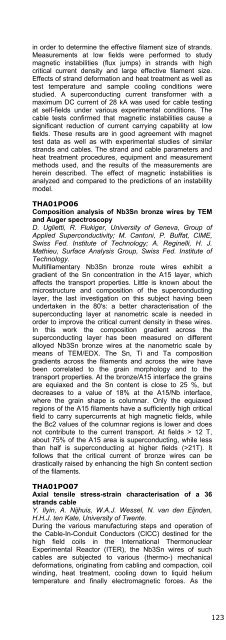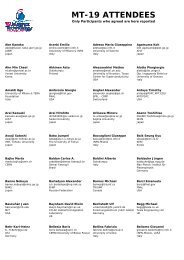Click here to download the abstract booklet in pdf format - MT19 - Infn
Click here to download the abstract booklet in pdf format - MT19 - Infn
Click here to download the abstract booklet in pdf format - MT19 - Infn
You also want an ePaper? Increase the reach of your titles
YUMPU automatically turns print PDFs into web optimized ePapers that Google loves.
<strong>in</strong> order <strong>to</strong> determ<strong>in</strong>e <strong>the</strong> effective filament size of strands.<br />
Measurements at low fields were performed <strong>to</strong> study<br />
magnetic <strong>in</strong>stabilities (flux jumps) <strong>in</strong> strands with high<br />
critical current density and large effective filament size.<br />
Effects of strand de<strong>format</strong>ion and heat treatment as well as<br />
test temperature and sample cool<strong>in</strong>g conditions were<br />
studied. A superconduct<strong>in</strong>g current transformer with a<br />
maximum DC current of 28 kA was used for cable test<strong>in</strong>g<br />
at self-fields under various experimental conditions. The<br />
cable tests confirmed that magnetic <strong>in</strong>stabilities cause a<br />
significant reduction of current carry<strong>in</strong>g capability at low<br />
fields. These results are <strong>in</strong> good agreement with magnet<br />
test data as well as with experimental studies of similar<br />
strands and cables. The strand and cable parameters and<br />
heat treatment procedures, equipment and measurement<br />
methods used, and <strong>the</strong> results of <strong>the</strong> measurements are<br />
<strong>here</strong><strong>in</strong> described. The effect of magnetic <strong>in</strong>stabilities is<br />
analyzed and compared <strong>to</strong> <strong>the</strong> predictions of an <strong>in</strong>stability<br />
model.<br />
THA01PO06<br />
Composition analysis of Nb3Sn bronze wires by TEM<br />
and Auger spectroscopy<br />
D. Uglietti, R. Flukiger, University of Geneva, Group of<br />
Applied Superconductivity; M. Can<strong>to</strong>ni, P. Buffat, CIME,<br />
Swiss Fed. Institute of Technology; A. Reg<strong>in</strong>elli, H. J.<br />
Mathieu, Surface Analysis Group, Swiss Fed. Institute of<br />
Technology.<br />
Multifilamentary Nb3Sn bronze route wires exhibit a<br />
gradient of <strong>the</strong> Sn concentration <strong>in</strong> <strong>the</strong> A15 layer, which<br />
affects <strong>the</strong> transport properties. Little is known about <strong>the</strong><br />
microstructure and composition of <strong>the</strong> superconduct<strong>in</strong>g<br />
layer, <strong>the</strong> last <strong>in</strong>vestigation on this subject hav<strong>in</strong>g been<br />
undertaken <strong>in</strong> <strong>the</strong> 80's: a better characterisation of <strong>the</strong><br />
superconduct<strong>in</strong>g layer at nanometric scale is needed <strong>in</strong><br />
order <strong>to</strong> improve <strong>the</strong> critical current density <strong>in</strong> <strong>the</strong>se wires.<br />
In this work <strong>the</strong> composition gradient across <strong>the</strong><br />
superconduct<strong>in</strong>g layer has been measured on different<br />
alloyed Nb3Sn bronze wires at <strong>the</strong> nanometric scale by<br />
means of TEM/EDX. The Sn, Ti and Ta composition<br />
gradients across <strong>the</strong> filaments and across <strong>the</strong> wire have<br />
been correlated <strong>to</strong> <strong>the</strong> gra<strong>in</strong> morphology and <strong>to</strong> <strong>the</strong><br />
transport properties. At <strong>the</strong> bronze/A15 <strong>in</strong>terface <strong>the</strong> gra<strong>in</strong>s<br />
are equiaxed and <strong>the</strong> Sn content is close <strong>to</strong> 25 %, but<br />
decreases <strong>to</strong> a value of 18% at <strong>the</strong> A15/Nb <strong>in</strong>terface,<br />
w<strong>here</strong> <strong>the</strong> gra<strong>in</strong> shape is columnar. Only <strong>the</strong> equiaxed<br />
regions of <strong>the</strong> A15 filaments have a sufficiently high critical<br />
field <strong>to</strong> carry supercurrents at high magnetic fields, while<br />
<strong>the</strong> Bc2 values of <strong>the</strong> columnar regions is lower and does<br />
not contribute <strong>to</strong> <strong>the</strong> current transport. At fields > 12 T,<br />
about 75% of <strong>the</strong> A15 area is superconduct<strong>in</strong>g, while less<br />
than half is superconduct<strong>in</strong>g at higher fields (>21T). It<br />
follows that <strong>the</strong> critical current of bronze wires can be<br />
drastically raised by enhanc<strong>in</strong>g <strong>the</strong> high Sn content section<br />
of <strong>the</strong> filaments.<br />
THA01PO07<br />
Axial tensile stress-stra<strong>in</strong> characterisation of a 36<br />
strands cable<br />
Y. Ily<strong>in</strong>, A. Nijhuis, W.A.J. Wessel, N. van den Eijnden,<br />
H.H.J. ten Kate, University of Twente.<br />
Dur<strong>in</strong>g <strong>the</strong> various manufactur<strong>in</strong>g steps and operation of<br />
<strong>the</strong> Cable-In-Conduit Conduc<strong>to</strong>rs (CICC) dest<strong>in</strong>ed for <strong>the</strong><br />
high field coils <strong>in</strong> <strong>the</strong> International Thermonuclear<br />
Experimental Reac<strong>to</strong>r (ITER), <strong>the</strong> Nb3Sn wires of such<br />
cables are subjected <strong>to</strong> various (<strong>the</strong>rmo-) mechanical<br />
de<strong>format</strong>ions, orig<strong>in</strong>at<strong>in</strong>g from cabl<strong>in</strong>g and compaction, coil<br />
w<strong>in</strong>d<strong>in</strong>g, heat treatment, cool<strong>in</strong>g down <strong>to</strong> liquid helium<br />
temperature and f<strong>in</strong>ally electromagnetic forces. As <strong>the</strong><br />
stra<strong>in</strong> state of <strong>the</strong> Nb3Sn strands determ<strong>in</strong>es <strong>the</strong>ir critical<br />
properties, it is essential for optimal cable and magnet<br />
design <strong>to</strong> ga<strong>in</strong> knowledge on <strong>the</strong> de<strong>format</strong>ion of strands<br />
<strong>in</strong>side CICC’s and its impact on <strong>the</strong> transport properties.<br />
The stress-stra<strong>in</strong> and de<strong>format</strong>ion of <strong>the</strong>se cables is be<strong>in</strong>g<br />
analysed by computation. However, experimental<br />
verification is required at least on sub-cable level. For<br />
validation of exist<strong>in</strong>g mechanical models, a new set-up has<br />
been built, which allows <strong>the</strong> stress-stra<strong>in</strong> test<strong>in</strong>g of ITER<br />
relevant sub-size cables. The cable consists of 36 nonreacted<br />
Nb3Sn strands and <strong>the</strong> <strong>to</strong>tal effective length is four<br />
times <strong>the</strong> twist pitch of <strong>the</strong> last cabl<strong>in</strong>g stage (480 mm). A<br />
cable sample is subjected <strong>to</strong> tensile axial stress, while <strong>the</strong><br />
axial effective elongation (stra<strong>in</strong>) is be<strong>in</strong>g recorded us<strong>in</strong>g<br />
extensometers. The radial de<strong>format</strong>ion is moni<strong>to</strong>red at<br />
room temperature by a digital camcorder. The test results<br />
at room and liquid helium temperatures are reported<br />
<strong>to</strong>ge<strong>the</strong>r with <strong>the</strong> s<strong>in</strong>gle strand mechanical characteristics.<br />
THA01PO08<br />
Axial tensile stress-stra<strong>in</strong> characterization of ITER type<br />
Nb3Sn strands <strong>in</strong> TARSIS<br />
N. van den Eijnden, A. Nijhuis, Y. Ily<strong>in</strong>, W.A.J. Wessel,<br />
H.H.J. ten Kate, University of Twente.<br />
S<strong>in</strong>ce <strong>the</strong> stra<strong>in</strong> state of <strong>the</strong> Nb3Sn filaments <strong>in</strong> strands<br />
determ<strong>in</strong>es <strong>the</strong> transport properties, it is crucial for<br />
optimiz<strong>in</strong>g <strong>the</strong> cable and magnet design <strong>to</strong> <strong>in</strong>vestigate <strong>in</strong><br />
detail <strong>the</strong> effective de<strong>format</strong>ion state of <strong>the</strong> strand <strong>in</strong><br />
CICC’s and <strong>to</strong> determ<strong>in</strong>e <strong>the</strong> impact on <strong>the</strong> transport<br />
properties and superconduct<strong>in</strong>g transition. The stressstra<strong>in</strong><br />
and de<strong>format</strong>ion of ITER Nb3Sn cables is be<strong>in</strong>g<br />
modeled and analysed by computation and basic<br />
experimental verification is required on strand level. In<br />
order <strong>to</strong> validate <strong>the</strong> mechanical models, a new set-up is<br />
developed, which allows efficient tensile stress-stra<strong>in</strong><br />
test<strong>in</strong>g of wires. This paper reports on <strong>the</strong> first axial tensile<br />
stress-stra<strong>in</strong> measurements that were performed on<br />
several types of ITER Nb3Sn strands at liquid helium,<br />
nitrogen and room temperature <strong>in</strong> <strong>the</strong> TARSIS (Test<br />
ARangement for Stra<strong>in</strong> Influence on Strands) setup. A<br />
double extensometer connected <strong>to</strong> <strong>the</strong> sample enables <strong>to</strong><br />
determ<strong>in</strong>e <strong>the</strong> stra<strong>in</strong> level w<strong>here</strong>as a load cell is used <strong>to</strong><br />
determ<strong>in</strong>e <strong>the</strong> stress level. The details of <strong>the</strong> take-off orig<strong>in</strong><br />
of <strong>the</strong> measured stress-stra<strong>in</strong> curves are discussed and <strong>the</strong><br />
data are evaluated with respect <strong>to</strong> expressions for <strong>the</strong><br />
stress-stra<strong>in</strong> curves.<br />
THA01PO09<br />
Extended characterization of European advanced<br />
Nb3Sn strands for ITER<br />
L. Muzzi, S. Chiarelli, A. della Corte, A. Di Zenobio, M.<br />
Moroni, A. Rufoloni, A. Vannozzi, ENEA; E. Salpietro, A.<br />
Vostner, EFDA CSU Garch<strong>in</strong>g.<br />
With<strong>in</strong> <strong>the</strong> framework of ITER-related projects, new tasks<br />
have been recently launched by EFDA CSU Garch<strong>in</strong>g<br />
(European Fusion Development Agreement Close Support<br />
Unit Garch<strong>in</strong>g), for <strong>the</strong> def<strong>in</strong>ition and production on<br />
<strong>in</strong>dustrial scale of advanced Nb3Sn strands, <strong>to</strong> be used <strong>in</strong><br />
<strong>the</strong> manufactur<strong>in</strong>g of <strong>the</strong> ITER high field CS and TF<br />
magnets. We performed an extended characterization of<br />
<strong>the</strong> advanced Nb3Sn strands com<strong>in</strong>g from different<br />
European companies, <strong>in</strong> terms of strand layout (diameter,<br />
thickness of Cr coat<strong>in</strong>g, Cu:non-Cu ratio, twist pitch length<br />
and orientation), critical transport current and n-value,<br />
RRR, and hysteresis losses. The results of <strong>the</strong><br />
measurement campaign show that <strong>the</strong> upgraded strands<br />
meet <strong>the</strong> latest ITER requirements, with an overall critical<br />
transport current of at least 200A (at 12T, 4.2K), equivalent<br />
<strong>to</strong> a non-Cu Jc of about 800A/mm2, a Cu:non-Cu ratio of<br />
123 MT-19 2005, Genova



